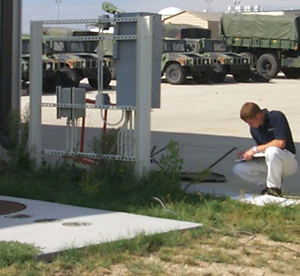US Air Force
KEMRON, under a multi-year blanket purchase order, provided comprehensive environmental consulting and analytical services to the Air Force, Institute for Environmental, Safety, and Health Risk Analysis Water Branch and other military installations nationwide. A summary of representative tasks follows:
Water and Wastewater Surveys: KEMRON conducted a water and wastewater copper source study at Little Rock AFB, AR to determine the cause of an increase in copper to the wastewater system. The survey also consisted of further investigation into the contribution of each identified source to the observed copper concentrations in the wastewater. Composite samples of wastewater were collected at seven locations utilizing 900 MAX Sigma automated composite samplers. Grab samples of potable water were collected from taps at various locations throughout the base. To characterize specific processes suspected to contribute to the observed metal concentrations in the wastewater, grab samples were collected from aircraft washes, oil/water separators, and storage drums. A field QA/QC program was used during this survey to verify the accuracy and reproducibility of laboratory results.
KEMRON conducted a water and wastewater compliance survey at Buckley AFB, CO to identify water supply, water distribution, and water quality issues. Scope of work included evaluation of overall condition of the potable water system, determining chlorine residuals throughout the base and presenting recommendations for locations with low chlorine levels, evaluation of existing oil/water separators, review of water distribution system drawings to determine dead-end locations and providing recommended corrective actions, review of backflow prevention program, and review of applicable state, federal, and air force regulatory requirements.
KEMRON conducted a water and wastewater copper source study at Shaw AFB, SC to assess existing water quality and determine the cause of elevated levels of copper in the wastewater system. Composite samples of wastewater were collected utilizing automated composite samplers. Grab samples of potable water were collected from taps at various locations throughout the base. A field QA/QC program was used during this survey to verify the accuracy and reproducibility of laboratory results.
Sanitary Survey: KEMRON conducted sanitary surveys at Goodfellow AFB, TX and Keesler AFB, MS. The purpose of the survey is to ensure that water free of microbiological contamination is delivered to consumers under normal operating conditions. The surveys consisted of reviewing the entire water system including source, treatment, storage and distribution as well as supporting information to identify shortcomings in the delivery of potable water. The surveys were conducted in conjunction with a water vulnerability assessment to help improve operational practices. Water Vulnerability Assessment: KEMRON conducted water vulnerability assessments at Goodfellow AFB and Keesler AFB. The surveys were conducted to identifying threats (e.g., natural disasters, accidents, or sabotage) to the installation’s ability to provide adequate quantities of potable water in emergency situations. The assessments helped minimize mission impacts by identifying weaknesses in water treatment, storage and distribution systems and by allowing the base to plan for system disruptions that cannot be prevented.
Cross Connection Surveys: KEMRON conducted cross connection surveys at Columbus AFB, MS; Goodfellow AFB; Keesler AFB; Eielson AFB, AK; Hurlburt AFB, FL; Dobbins ARB, GA; Homestead ARB, FL; March ARB, CA; General Mitchell ARB, WI; Grissom ARB, IN; Luke AFB, AZ; and Snelling ARB, MN. The goal of the surveys was to provide corrective action recommendations for: ensuring compliance with Safe Drinking Water Act (SDWA) requirements to eliminate potential or actual cross-connections; to maintain drinking water system sanitation; and to protect the system from vulnerabilities. The studies identified actual and potential public water system cross connections, inventoried all existing backflow prevention devices and provided corrective action recommendations including replacement or repair of plumbing fixtures and installation of appropriate air gaps, backflow prevention devices, atmospheric and pressure vacuum breakers, and reduced pressure zone devices.
